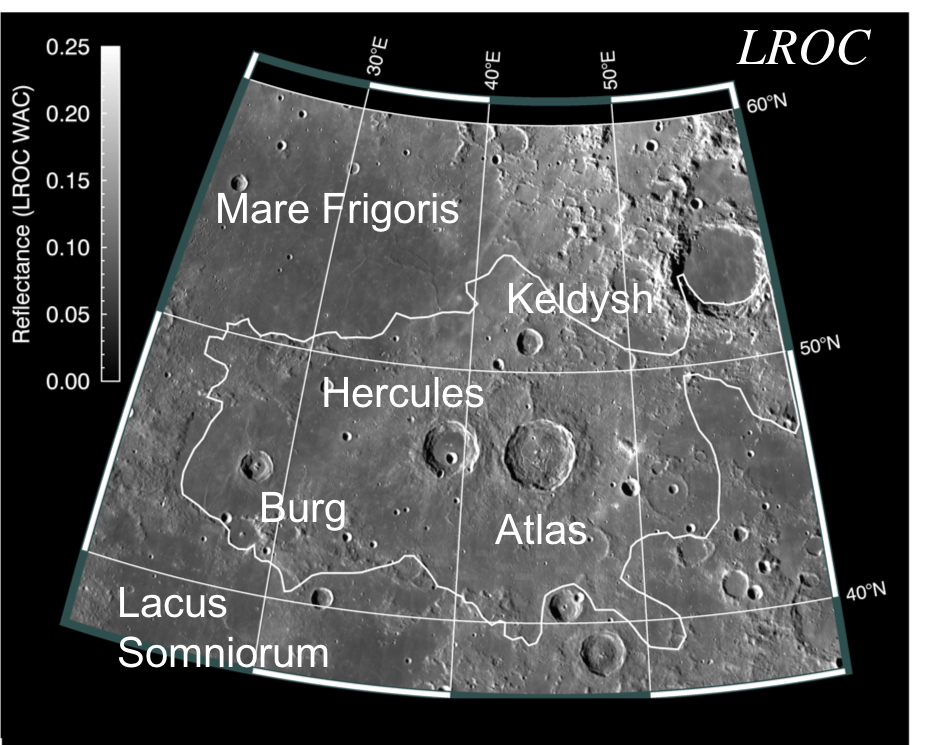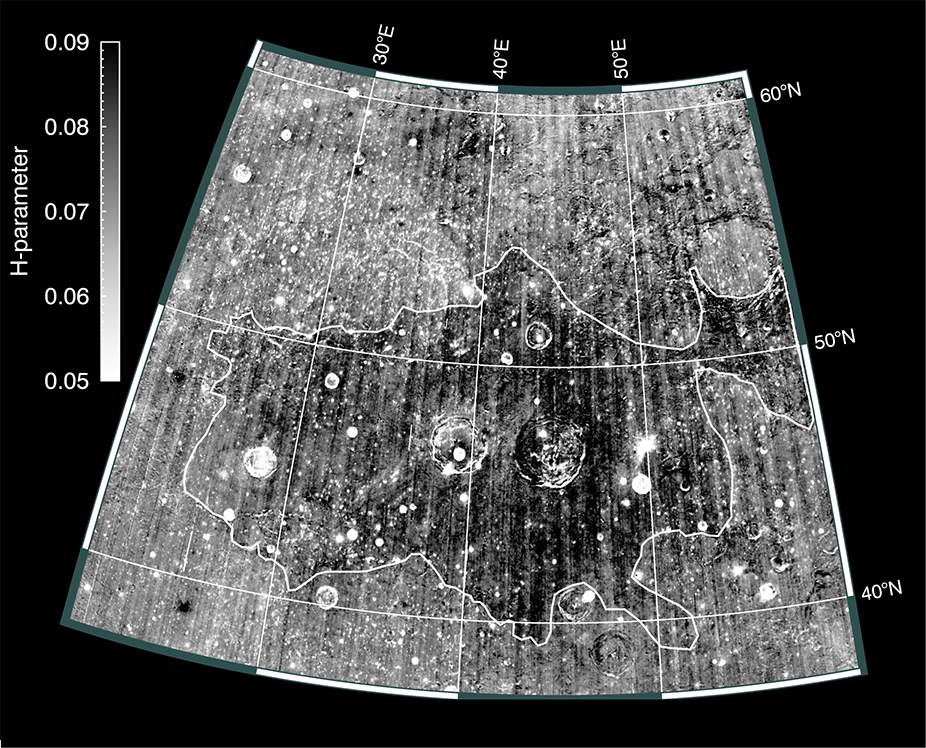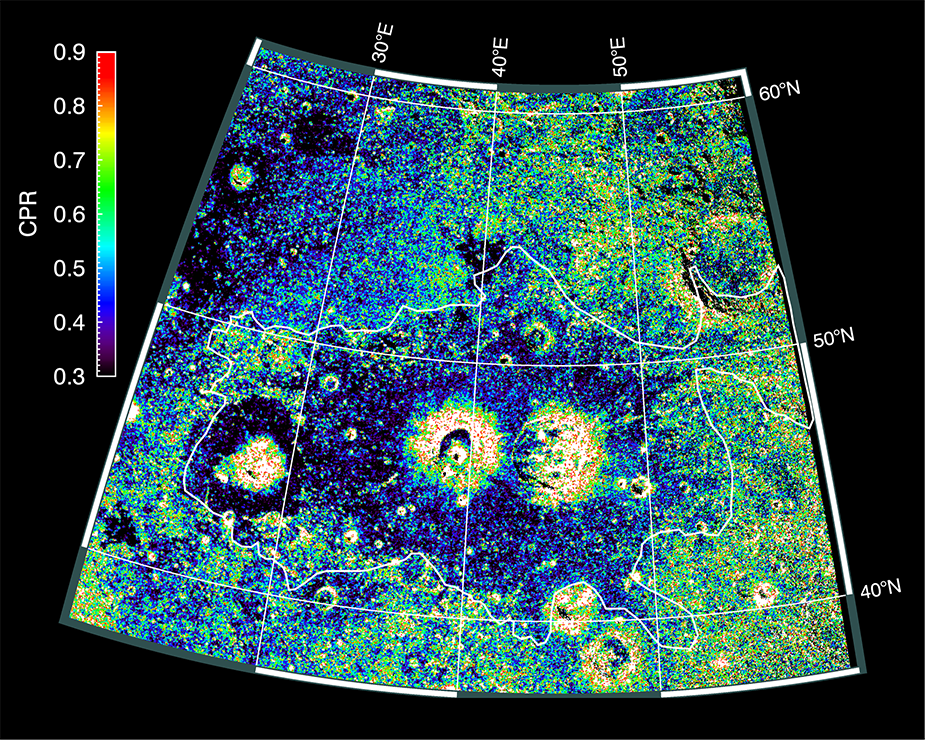An Atlas/Hercules thermophysical anomaly examination relative to radar dark halo craters and its regional volcanism
- Johns Hopkins Applied Physics Lab
Introduction: A new class of enigmatic deposits on the Moon has emerged since the Lunar Reconnaissance Orbiter entered orbit that contrasts with the lunar regolith at large. Unlike optical anomalies, such as swirls, these deposits are unusual for their thermophysical characteristics. One class consists of lunar cold-spot craters, so-named because they are characterized by extensive regions, relative to their cavity diameter and depth, of anomalously cold regolith temperatures in nighttime Diviner data [2]. These cold regions are not easily explained by conventional impact mechanics. Hayne et al. [1] further characterized these features with high Diviner-derived H-parameter values which provides a convention for describing thermophysical depth profiles. The H-parameter governs the variation of density and conductivity of the lunar regolith with depth and is independent of temperature. The high H-parameter values that cold-spot craters show suggests their thermophysical properties are consistent with a ‘fluffed up’ regolith in the upper 10 to 30 cm created by some aspect of the impact process.
Also reported by [1] were thermophysically distinct signatures associated with pyroclastic flows and a thermophysically unique region near ~45°N, ~45°E. This region is southeast of Mare Frigoris and is more expansive than typical cold spots, encompassing the craters Atlas, Hercules, Burg, and Keldysh. With thermophysical similarities to cold spots, initially the region seemed to fit the definition of a cold spot. However, the region is without similar geomorphological characteristics and bears dramatic differences in spatial scale to cold spots and conventional lunar pyroclastic deposits. The ‘Atlas thermophysical anomaly’, as we denote it here, also consists of high H-parameter values relative to its surroundings, suggesting it consists of finer regolith materials, with higher porosities (is ‘fluffier), and has lower thermal inertias than typical regolith. But, the mechanism necessary to form such a large thermophysically distinct region is less clear making it enigmatic even relative to cold-spots.
As mentioned previously, the regions thermophysical values are also consistent with pyroclastic deposits. Further, Atlas crater itself is a floor fractured crater with previously documented evidence of magmatic/volcanic activity in the form of pyroclastic deposits [3, 4]. However, these pyroclastic deposits are localized to the Atlas crater cavity floor and no known studies have inferred additional expansive volcanic activity that would be coincident within the thermophysical boundaries until now.
Making the region more scientifically intriguing, the craters Atlas, Hercules, and Burg have each previously been identified as radar dark halo craters [5]. Ghent et al. [6]’s most recent analysis of the physical properties of radar dark halo craters reported that the halo material is depleted in surface rocks, but are otherwise thermophysically indistinct from background regolith. This contrasts with what we observe in H-parameter maps of the Atlas region. Here, with additional radar, TIR, and gravity data sets for perspective we re-examine the region relative to other traditional radar dark halo craters in search of similarities and differences in formation mechanism(s) and timing.
Objectives: The Atlas region may provide a unique insight into how the lunar regolith is being weathered that contrasts with cold spots in general. For example, unlike the Atlas region, cold spots are not typically detected in radar wavelengths. Here we focus our investigation on the physical properties of the Atlas region and how they may or may not be synergistic with its thermophysical properties with increasing depth. We do this with a combination of monostatic and bistatic radar observations of the region at multiple wavelengths, and we postulate potential formation mechanisms of this region relative to lunar cold spots and radar-dark halo craters (e.g., new craters, pyroclastic deposits, etc.). And finally, we examine GRAIL gravity data to determine if additional information can be derived from the deeper subsurface regarding magmatic/volcanic potential. Questions we aim to answer include: How does the mechanism that formed the Atlas thermophysical anomaly contrast with that of typical cold spots, pyroclastic deposits, and radar dark halo craters?
Methods: Study of this region starts with the analysis of Diviner H-parameter and rock abundance maps relative to Mini-RF monostatic S-band (12.6 cm) and Earth-based Arecibo Observatory-Greenbank Observatory bistatic P-band (70.3 cm) observations. The contrast in physical sensitivity between circular polarization ratio of these two radar data sets and Diviner’s thermophysical information is complementary regarding surface and subsurface material, size, and relative stratigraphic depths. We also compare these data with optical and GRAIL-derived cryptomare detection maps to examine the potential of magmatic source influences in the region.
Discussion: In 12.6 and 70 cm image data (Figure 1), the Atlas region shows distinctive low backscatter characteristics more consistent with radar-dark halo craters than lunar cold-spots which are usually undetectable at radar wavelengths [1, 5]. The radar-dark halo craters Burg, Atlas, and Hercules show backscatter properties consistent with lunar regolith devoid of scatterers (boulders, fractures, and corner reflectors) to at least ~10 m depths, significantly greater depths than sensed by Diviner. However, Atlas is thermophysically distinct from is surroundings, unlike most radar-dark halo craters which show little contrast in the H-parameter relative to background regolith, consistent with Ghent et al. [6]’s findings. This suggests something about this region is unique from most other RDHCs.



Figure 1
GRAIL-derived cryptomare thickness maps of [7; Fig. 2] show modest thicknesses (400 to 600 m) starting on the northern side of the anomaly that cut down west of Hercules crater and surround Burg with increasing thicknesses (600 – 800 m). Volcanism is pervasive here on the western anomaly complicating the geologic history and inferred formation mechnism. While proximity may suggest volcanism influenced the anomalies formation, though likely did not instigate it, it was not a uniform influence across the anomaly. Atlas crater sits alone, apparently free of volcanic influence, with no optical or gravity cryptomare detections in its vicinity.
Figure 2
References: [1] Hayne et al. (2017) JGR. [2] Bandfield et al. (2014) Icarus. [3] Gaddis et al. (2003) Icarus. [4] Gaddis et al. (2000) JGR. [5] Ghent et al. (2005) JGR. [6] Ghent et al. (2015) Icarus. [7] Izquierdo et al. (2024) JGR.
How to cite: Cahill, J., Marting, A., Izquierdo, K., and Patterson, W.: An Atlas/Hercules thermophysical anomaly examination relative to radar dark halo craters and its regional volcanism, Europlanet Science Congress 2024, Berlin, Germany, 8–13 Sep 2024, EPSC2024-1172, https://doi.org/10.5194/epsc2024-1172, 2024.